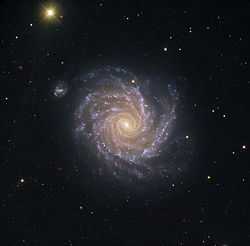NGC 1232
| NGC 1232 | |
|---|---|
 1.5 m Danish telescope image from the ESO La Silla Observatory in Chile | |
| Observation data (J2000 epoch) | |
| Constellation | Eridanus |
| Right ascension | 03h 09m 45.5s[1] |
| Declination | −20° 34′ 46″[1] |
| Redshift | 0.005347[1] |
| Helio radial velocity | 1603 ± 1 km/s[1] |
| Distance |
61 ± 8.5 Mly (18.7 ± 2.6 Mpc)[2] |
| Type | SAB(rs)c[1] |
| Apparent dimensions (V) | 7′.4 × 6′.5[1] |
| Apparent magnitude (V) | 10.9[1] |
| Notable features | large satellite |
| Other designations | |
| PGC 11819,[1] Arp 41[1] | |
| See also: Galaxy, List of galaxies | |

NGC 1232 is an intermediate spiral galaxy about 60 million light-years away[2] in the constellation Eridanus.
It is dominated by millions of bright stars and dark dust, in spiral arms rotating about the center. Open clusters containing bright blue stars are sprinkled along these spiral arms, with dark lanes of dense interstellar dust between. Less visible are dim normal stars and interstellar gas, producing such high mass that they dominate the dynamics of the inner galaxy. Not visible is matter of unknown form called dark matter, needed to explain the motions of the visible material in the outer galaxy.
NGC 1232 and its satellite are part of the Eridanus cluster of galaxies, along with NGC 1300.
ESO 547-16
ESO 547-16 is a satellite galaxy of NGC 1232.[3] It is thought to be the cause of unusual bending in the spiral arms. In 1988, NGC 1232A was estimated to be 68 million light-years away[4] while NGC 1232 was estimated to be 65 million light-years away.[2]
See also
References
- ↑ 1.0 1.1 1.2 1.3 1.4 1.5 1.6 1.7 1.8 "NASA/IPAC Extragalactic Database". Results for NGC 1232. Retrieved 2006-11-25.
- ↑ 2.0 2.1 2.2 "Distance Results for NGC 1232". NASA/IPAC Extragalactic Database. Retrieved 2010-06-22.
- ↑ "NASA/IPAC Extragalactic Database". Results for NGC 1232A. Retrieved 2010-06-22.
- ↑ "Distance Results for NGC 1232A". NASA/IPAC Extragalactic Database. Retrieved 2010-06-22.
External links
| Wikimedia Commons has media related to NGC 1232. |
- NGC 1232 on WikiSky: DSS2, SDSS, GALEX, IRAS, Hydrogen α, X-Ray, Astrophoto, Sky Map, Articles and images
- SIMBAD: NGC 1232
- SIMBAD: NGC 1232A
- Antilhue-Chile: NGC 1232 in Eridanus
- The Scale of the Universe (Astronomy Picture of the Day 2012 March 12)
Coordinates: ![]() 03h 09m 45.5s, −20° 34′ 46″
03h 09m 45.5s, −20° 34′ 46″